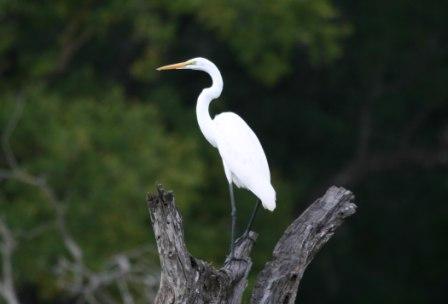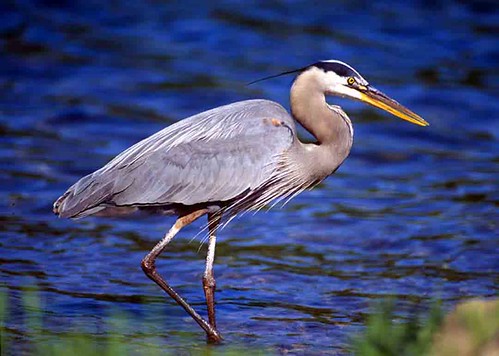
12:06 a.m. - 2005-05-19
Herons! Pics 4/16/2007
Greetings, Critter Lovers!
I hope you are all well, and staying dry during this soggy weather.
This weekend was significant in that I didn't work! Hence no entries. In addition, there were many romantic, non-animal related dates, including a wedding and seeing the "Olympic Hopefuls" playing downtown.
Don't fret though, R and I took advantage of the dry weather on Sunday, making a journey to the creature-laden wetland a mere one mile south of the Mall of America!
The animals we saw were myriad in nature: A leech under a log, a garter snake, a turtle, geese, yellow finches, cardinals and, not one but two types of herons! The great blue heron and the great egret!
In the "ew, gross" section, we saw two dead beavers. One was a skeleton positively identified by its size and the giant orange teeth protruding from the skull. The second was a brown-furred floating corpse, which thankfully was not close by.
Rest in peace, O beavers! We saw many freshly bitten tree trunks though, so some beavers survive and thrive in the MN river.
Later on Sunday my sister A called from WI. Get this; the night before she'd dreamt of TWO BEAVERS! I'll let you ponder the significance.
So as you can see, I have many animal options for this entry. I think the most exciting sighting this Sunday was that of the great egrets, so we'll discuss herons.
Now, egrets are herons. R and I didn't know this, although I guess it could be obvious. The problem is that there are two types of white egrets (well, in North America). We witnessed the smaller cattle egret in Richfield last year, Bubulcis iris, which is 19 to 21 inches long.
But we'd never seen the majestic great egret (Ardea alba), which is a meter tall and has a wingspan of a meter. They were spectacular to see flying around, stalking the waters, and perching in the trees next to the river.
The great blue heron (Ardea herodias) we saw was gorgeous as well; it had a white and black striped head, bluish feathers, and had slender plumes hanging down (which I now know is related to mating season). We watched it in the binoculars; it was circling a small pond and calling out, perhaps for its lovah!
The great blue heron is the largest North American heron. It is found from Alaska to the Galapagos islands. Unlike cranes and ibises (cousins), herons curve their necks in when they fly.
Herons require shallow water for feeding, and tend to stick to lakes and rivers with this characteristic, along with cover nearby. Herons are usually solitary hunters, but a group of them is called a heronry. These big birds use their sharp beaks to spear and bite fish, amphibians, and insects.
Egrets have been protected in America since 1812, when they were nearly killed to extinction for their slender white plumes. It seems they are found on the eastern half of the continent. You'll notice herons poised very still, over the water. Scientists have discovered that they kill larger and higher-quality food that way, versus stalking around and eating anything that comes their way.
The cattle egret is a far traveling bird! In the last 150 years they've moved from Africa and spread to near worldwide coverage. Cattle egrets are about 20 inches long and have shorter legs than the herons mentioned above. They can be found in wetlands, but obviously love their beef! I mean, they follow livestock around, looking for the tasty insects flushed out by the animals. Occasionally cattle egrets will sit right on the cow to find bugs! Cattle egrets are very social and often nest together in groups. Although the larger great egrets we saw were partying in a group of eight.
Cattle egrets have the same love habits as listed below, except apparently during the male's mating display, several females will jump on his back! That's hot. He shoves away all but one and then the XXX showdown occurs.
Side note: This reminds me of the way my boyfriend teasingly pushed me away the other night when I suggested we watch the new ballroom dancing tv shows!
So, let's discuss heron love. Egrets and blue herons share the same traits in this regard. Male herons have a territory, where they put on a mating display to attract a female. After the love connection, the pair builds a large, lacy nest high in a tree within the male's territory. These nests are reused, and often the accumulated waste from the birds eventually kills the tree. Three to five eggs are laid, and both parents take turns warming them. After about 27 days, the eggs hatch, and both parents provide food for the nestlings. The babies fly after about 50 days, and the family unit stays together the rest of the summer.
If some eggs are destroyed, a female egret can lay more to replace them. It seems that heron eggs and babies are the most vulnerable to predation, especially from enterprising raccoons. Crows and vultures also attack from above.
Adult herons can be killed by power lines and cars, but are mostly threatened by habitat loss. Pesticides have affected the strength of the egg shells, as well.
I hope you see some of these majestic birds this summer!
lovies, Wendell
|



